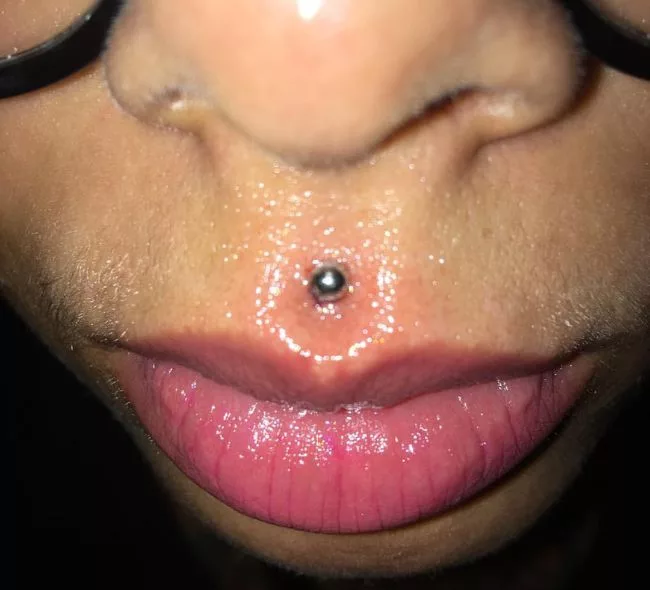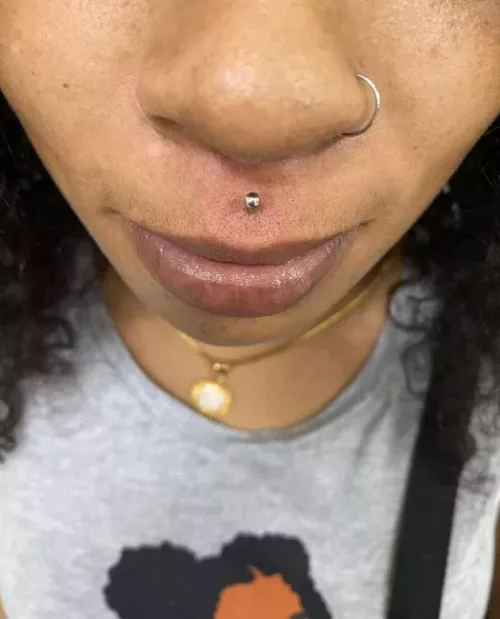Medusa Piercing in Nairobi, Kenya
(Considerations, Procedure, Pain Threshold, Healing Time, Aftercare Tips, and Jewelry Guide.)
A medusa piercing is a type of body piercing that is placed on the philtrum, the area of skin between the nose and the upper lip. The medusa piercing is often done with a labret stud, which is a type of body jewelry that consists of a straight bar with a flat disc on one end and a ball or other decorative element on the other end. The bar is inserted through the piercing and the disc is worn on the inside of the mouth, while the ball or decorative element is visible on the outside. The medusa piercing is typically worn in the center of the philtrum, but it can also be placed off to the side. It is a popular choice for those who want to decorate their face with piercings and can be worn by both men and women.
Medusa Piercing
Like with any piercing, you must follow the right aftercare instructions, allow enough time for healing, and be aware of any possible health hazards. You’ve arrived to the right site if you’re thinking about getting a Medusa or are just interested about the piercing procedure! To help you get started on your Medusa piercing journey, here are some frequently asked questions we encounter.
Considerations before getting a Medusa Piercing
Getting a Medusa piercing is a personal decision, and it’s important to carefully consider several factors before going through with the procedure. Here are some considerations to keep in mind:
- Pain Tolerance: Consider your pain tolerance level. While the pain of a Medusa piercing is generally brief, it can be intense for some individuals. If you have a low pain tolerance, discuss pain management options with your piercer.
- Placement: Think about the exact placement of your Medusa piercing. It should be centered in the philtrum, but you can work with your piercer to determine the precise location that suits your facial anatomy and aesthetic preferences.
- Professional Piercer: Research and choose a reputable and experienced professional piercer who follows strict hygiene and safety protocols. Read reviews and get recommendations to ensure you’re in capable hands. At Rebel Inks Tattoo Removal and Piercings Parlour we have extensive experience and experienced team that is geared to offer you the best services Contact Us Today for further consultation and scheduling
- Jewelry: Consider the type of jewelry you want for your Medusa piercing. Labret studs with flat backplates and decorative ends are typical choices. Decide on the material, size, and style of the jewelry that appeals to you.
- Healing Time: Understand that Medusa piercings require a healing period, usually around 6 to 8 weeks for initial healing and several months for full healing. Be prepared for the commitment required for proper aftercare during this time.
- Aftercare: Be ready to follow aftercare instructions diligently. This typically involves cleaning the piercing with a saline solution, avoiding touching it with dirty hands, and maintaining good oral hygiene.
- Swelling: Expect some swelling after the piercing, which can last for a few days to a week. You may need over-the-counter pain relievers and ice packs to manage swelling.
- Oral Health: Good oral hygiene is crucial with a Medusa piercing. Regularly rinse your mouth with an alcohol-free or saline mouthwash to keep the inside of the piercing clean.
- Lifestyle Considerations: Think about how the piercing may affect your daily life, including eating, speaking, and any activities that involve your mouth. You may need to make some adjustments during the healing process.
- Work or School Policies: Consider any policies at your workplace or school regarding facial piercings. Some institutions may have dress code requirements that could affect your choice of jewelry or placement.
- Commitment: Understand that removing the jewelry too soon can lead to complications, so be committed to leaving the jewelry in place until the piercing has fully healed.
- Potential Risks: Be aware of potential risks associated with piercings, including infection, migration, and scarring. It’s important to choose a reputable piercer and follow proper aftercare to minimize these risks.
- Allergies and Sensitivities: If you have known allergies or sensitivities to certain metals, inform your piercer to ensure they use hypoallergenic jewelry materials.
Taking these considerations into account will help you make an informed decision about getting a Medusa piercing. It’s essential to choose a reputable piercer, follow aftercare instructions, and be patient during the healing process to ensure a successful and safe piercing experience.
Medusa Piercing Procedure
The Medusa piercing procedure should be performed by a professional piercer in a clean and sterile environment. Here are the general steps involved in the Medusa piercing procedure:
- Consultation: You’ll typically begin with a consultation with your piercer. During this discussion, you can ask questions, discuss placement options, and address any concerns you may have. Your piercer will assess whether you are a suitable candidate for the Medusa piercing.
- Sterilization: Your piercer will thoroughly clean and sterilize their hands and the equipment used for the piercing to minimize the risk of infection. They should also wear gloves and use sterile, single-use needles and jewelry.
- Marking: Using a sterile surgical marker, your piercer will mark the precise location where the Medusa piercing will be placed. This is done while you are sitting up, allowing you to see and approve the placement. You can work with the piercer to determine the exact placement that suits your facial anatomy and preferences.
- Piercing: Once you are comfortable with the placement, your piercer will use a sterilized needle to create the piercing. The needle is typically inserted from the outside of the philtrum (above the upper lip) to the inside of the mouth. A receiving tube may be used inside the mouth to guide the needle and jewelry.
- Inserting Jewelry: After the piercing is made, your piercer will insert the chosen jewelry, which is typically a labret stud. The labret stud consists of a flat backplate on the inside of your mouth and a decorative end on the outside. Decorative ends can vary in design and might include studs, beads, gemstones, or other decorative elements.
- Cleaning and Aftercare: Your piercer will provide you with instructions on how to clean and care for your Medusa piercing. Proper aftercare typically involves cleaning the piercing with a saline solution, avoiding touching it with dirty hands, and maintaining good oral hygiene.
- Payment and Aftercare Products: You’ll likely need to pay for the piercing and any aftercare products recommended by your piercer, such as saline solution or healing cream.
- Follow-Up: It’s important to follow up with your piercer as scheduled to check on the healing progress and address any concerns.
- Changing Jewelry: It’s generally recommended to wait until the piercing has fully healed before changing the jewelry. Consult your piercer for guidance on changing jewelry and selecting appropriate sizes and styles.
Remember that the procedure should be done by a professional piercer in a reputable studio that follows strict hygiene and sterilization procedures. If you experience any signs of infection, excessive swelling, or other problems during the healing process, Contact Us or a healthcare professional for guidance. Following proper aftercare and being patient during the healing process are essential for a successful and safe Medusa piercing.

Medusa Piercing FAQ’s
How Painful is a Medusa Piercing?
The pain level of a medusa piercing can vary depending on a number of factors, including the individual’s pain tolerance, the skill of the piercer, and the size of the jewelry being used. Some people may find the process of getting a medusa piercing to be relatively painless, while others may experience more discomfort.
One factor that can affect the pain level of a medusa piercing is the location of the piercing. The philtrum, or the area of skin between the nose and the upper lip, has a relatively thin layer of skin and is not heavily muscled, so the piercing process may be less painful than piercings in other areas of the body where there is thicker skin and more muscle.
It’s also important to keep in mind that everyone’s pain tolerance is different, so what may be a relatively painless experience for one person may be more uncomfortable for another. If you are concerned about the pain level of a medusa piercing, it’s a good idea to talk to your piercer about your concerns and ask for their advice on how to minimize discomfort.
In general, it is normal to experience some discomfort or pain when getting any type of piercing, but the pain should be manageable and should subside relatively quickly after the piercing is done. If you are experiencing excessive pain or other unusual symptoms after getting a medusa piercing, it’s important to contact your piercer or a healthcare professional for advice.
Medusa Piercing Healing time and Aftercare instructions
The healing time for a medusa piercing can vary, but most people can expect the piercing to take anywhere from 4 to 6 weeks to heal completely. During this time, it’s important to follow proper aftercare instructions to ensure that the piercing heals properly and to minimize the risk of infection.
Here are some general guidelines to follow during the healing process:
- Keep the piercing clean: Use a saline solution or mild soap and water to clean the piercing twice a day. Avoid using alcohol or hydrogen peroxide, as these can irritate the skin and slow down the healing process.
- Avoid touching the piercing: It’s important to keep your hands clean when handling the piercing to avoid introducing bacteria or other contaminants.
- Avoid exposing the piercing to water: Avoid swimming or soaking the piercing in water, such as in the shower or bath, until it is fully healed.
- Avoid playing with or rotating the jewelry: It’s important to leave the jewelry in place and avoid playing with it or rotating it, as this can disrupt the healing process and increase the risk of infection.
- Avoid eating certain foods: Avoid eating spicy or acidic foods, as well as hot drinks, as these can irritate the piercing and slow down the healing process.
- Be gentle when brushing: Be gentle when brushing the area around the piercing, as it can be easily irritated during the healing process.
If you have any concerns about the healing process or experience any unusual symptoms, such as excessive swelling or discharge, it’s important to contact your piercer or a healthcare professional for advice.
Medusa Piercing Jewelry type
The labret, also known as a flatback, post, or stud, is a suitable design for a new medusa piercing. Once the piercing has healed, other abstract jewelry types may be worn and replaced, however it is advised by professionals that you wear a labret style during the initial healing phase.
The most common lip stud sizes for Medusa piercings are 14G or 16G. Make sure the lip stud doesn’t stretch too far or pinch too firmly while selecting the barbell’s length. Too-small jewelry can become embedded in the skin, while larger jewelry may scrape against your gums and cause your gum line to recede.
Medusa Piercing Jewelry Materials
Implant grade titanium: Also known as F-136 titanium, this is an ideal choice due to its biocompatibility and the fact that it’s hypoallergenic. For those with a nickel allergy or an overall sensitivity to metals, titanium can be a superior option.
Solid gold: If you’re going the gold route, make sure you’re choosing something of high quality. Pearce and other experts agree that 14-karat gold is best for new piercings. At Rebel Inks Tattoo Kenya, the most important rule of thumb, always avoid nickel since nickel is the most common allergy.
How To Change Medusa Piercing Jewelry
The Medusa piercing is easier to change the jewelry in than some other piercings since it is positioned perpendicular to the skin.
- By loosening the jewelry’s back and pushing the stud out of the piercing from the front, you can gently remove any existing jewelry that is in place.
- Unscrew the internally threaded back of the new jewelry.
- Make a gentle entry into the piercing hole with the prong of the Medusa lip stud. Try to avoid moving the jewelry too much.
- Even after the piercing has entirely healed, vigorous movement may still harm it.
- Screw the back into the prong. Make sure that you don’t tighten too much so that you don’t damage the threading. It should be firm but not too tight.
Related Piercings
OUR LOCATION
Areas We Serve
NAIROBI
KIAMBU
KAJIADO
MACHAKOS


